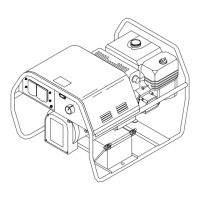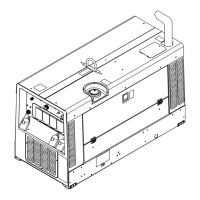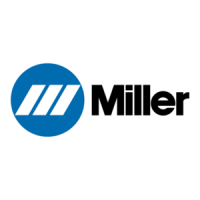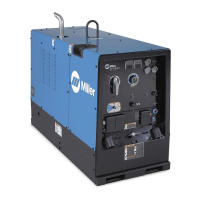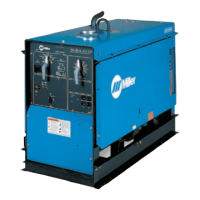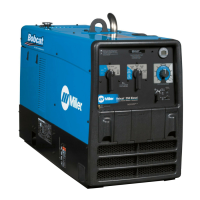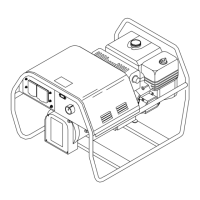
Do you have a question about the Miller Electric Blue Star 3500 and is the answer not in the manual?
| Brand | Miller Electric |
|---|---|
| Model | Blue Star 3500 |
| Category | Welding System |
| Language | English |
Explains the meaning of symbols used in the manual for safety alerts.
Details potential dangers associated with arc welding processes.
Outlines safety precautions related to the engine, fuel, and moving parts.
Covers dangers associated with compressed air systems and pressure.
Presents symbols for specific installation, operation, and maintenance safety points.
Lists chemicals known to cause cancer or birth defects as per California law.
References key safety standards and organizations for welding and allied processes.
Discusses electromagnetic fields and potential interference, including pacemaker considerations.
Defines symbols used in the manual for various components and functions.
Details the welding modes, power output, and engine specifications for the unit.
Provides physical dimensions, weight variations, and safe operating tilt angles.
Illustrates fuel usage based on welding output and auxiliary power load for Kohler engines.
Shows fuel consumption graphs for Honda-powered units based on load.
Explains duty cycle percentages for rated welding amperage to prevent overheating.
Displays the generator's AC power output capability in amperes versus load.
Illustrates the generator's voltage and amperage output capabilities across different settings.
Guides on proper placement, airflow clearance, and movement for the welding generator.
Details the procedure for grounding the generator frame to a vehicle for safety.
Explains how to ground the generator when connecting to building electrical systems.
Lists daily checks for Kohler-powered units, including fluids and fuel valve.
Lists daily checks for Honda-powered units, including fluids and fuel valve.
Provides instructions for connecting the battery on electric-start models.
Guides on connecting cables to the generator's positive and negative weld output terminals.
Offers a chart to select appropriate weld cable sizes based on amperage and cable length.
Identifies and explains the controls for Kohler-powered welding generators.
Identifies and explains the controls for Honda-powered welding generators.
Provides a detailed explanation of each control for Honda-powered units.
Describes the features and operation of the standard USA generator power panel.
Shows various optional generator power panels available for different regions.
Details the power ratings and limitations for different generator power panels.
Provides wiring instructions for installing a specific 120/240V twistlock plug.
Outlines a schedule for regular maintenance tasks based on operating hours.
Explains the information found on the engine maintenance label and service intervals.
Describes the function of the ignition circuit breaker and how to reset it.
Guides on adjusting engine speeds for optimal weld and generator power output.
Details how to adjust engine speed for Honda units for proper operation.
Lists common welding output problems and their corrective actions.
Lists common generator power output issues and their solutions.
Covers troubleshooting steps for engine starting, operation, and battery issues.
Shows the main electrical circuit diagram for the welding generator.
Illustrates wiring diagrams for various generator power panels.
Continues wiring diagrams for different regional generator power panels.
Advises on choosing appropriate electrical equipment and plugs for generator power.
Details grounding procedures when mounting the generator on a vehicle or trailer.
Explains grounding methods for connecting the generator to building systems.
Guides on calculating power requirements for various types of equipment.
Lists power requirements for common industrial motors.
Provides power requirements for typical farm and home equipment.
Lists power requirements for various contractor tools and equipment.
Explains how to determine the starting power needed for motors.
Advises on load management and starting non-resistive loads.
Shows common wiring configurations for using the generator as standby power.
Provides charts for selecting extension cords based on current, voltage, and length.
Details the step-by-step process for performing stick welding.
Offers guidance on selecting electrodes and appropriate amperage settings.
Explains arc starting methods (scratch, tap) and electrode holder positioning for welds.
Illustrates good and poor weld bead characteristics and their contributing factors.
Discusses variables like angle, arc length, speed, and weave patterns for weld quality.
Covers procedures for butt, lap, and tee joints, including tack welds and bevels.
Details weld testing and addresses common issues like porosity and spatter.
Covers problems related to weld penetration depth and heat input.
Addresses issues like burn-through, waviness, and distortion in welding.
Provides an exploded view and parts list for the main assembly of the welding generator.
Illustrates various generator power panels and their associated components.
Outlines the terms, conditions, and coverage of the Miller limited warranty for equipment.
Section for users to record purchase details for warranty and service purposes.
Provides contact information and steps for obtaining service and support for the equipment.
